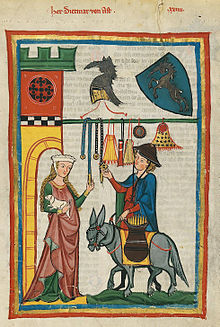Alms bag

As alms bag ( "aumônières sarrazinoises", "bourse", "gibecière", plasterers, according to Chaucer) refers to small, usually elaborately decorated bags of precious materials, the latest from the High Gothic formed an important clothing accessory in Central Europe. Alms bags are mostly flat with silk and gold wire embroidery and were not only practical substitute for the medieval clothes missing bags , but also precious object representation.
History and origin
The first written sources to mention the alms bag include the regulations of the French silk sticker guilds from the early 13th century. Although the term "sarrazinoises" used suggests an origin from the Arab region, they can be traced back to Europe in the 12th century. However, earlier specimens from the Byzantine region indicate that it is actually a tradition from the Mediterranean region.
In its name, the alms bag reflects the biblically required generosity of Christians for the needy, which in the Middle Ages found numerous equivalents in words and images.
use
It is assumed that in the Middle Ages the alms bag , which had no pockets in clothing , was a repository for numerous small items of everyday life that were often carried with you - but certainly for money , which the bag cutters, the bag cutters, hung freely on their belts be let. In the course of the 14th century, this apparently led to the decorative but eye-catching bag being increasingly worn under the second outer clothing, the surcot , the Schaube or the Houppelande .
In addition to the possibility of showing off one's own prosperity with a particularly richly crafted bag, text sources from the 12th century onwards show that the bags, often decorated with Minnesota scenes , were popular gifts of love. The striving to make gifts as lavish as possible, which was strongly associated with reputation, prestige and advertising in the courtly environment, manifested itself in many forms in the context of knightly culture, which flourished in France, especially in the 14th century.
Manufacturing in the Middle Ages
A particularly large number of specimens from French production have survived, which, together with the guild rules in Paris and some other references, makes it clear that Paris is ahead of other centers of decorative embroidery such as B. Cologne was a strong producer of such bags from the 13th century. At this time, the " opus anglicanum ", the figurative, English-influenced embroidery style of profane and loving scenes , became increasingly popular. In the 14th century, French production, which according to trade registers in its center of Paris employed over 124 mostly female specialists, perfected the “nue” technique from Goldlahn , which uses the fastening threads to create decorative patterns.
The silk artisans who lived and worked in certain parts of Paris had to submit to strict tests that were supposed to ensure the consistent quality of this product. The professions, which often shared shops and workshops, made high demands on their apprentices and developed rules to protect techniques and materials from spies from other workshops in other cities.
Shapes and construction details
Alms bags can be found in various forms. Bags of smaller dimensions, with a rectangular or slightly trapezoidal shape, are dominant. Obtained bags primarily have closures in the form of ribbons pulled through holes in the nest , but the drawstring is also used. What they have in common is the embroidery on both sides with figurative motifs or patterns, whereby these are almost exclusively flat, i.e. H. the entire underground is embroidered. The materials are almost exclusively, except for the embroidery base made of linen , of a noble nature, i. H. Silk with gold , silver and pearls as well as precious stones .
literature
- Geoff Egan, Frances Pritchard: Dress Accessories. c. 1150 - c. 1450 (= Medieval finds from Excavations in London 3). New Edition. Boydell Press, London 2008, ISBN 0-85115-839-0 .
- Marie Schuette , Sigrid Müller-Christensen: The embroidery work. Ernst Wasmuth, Tübingen 1983, ISBN 3-8030-5023-5 .